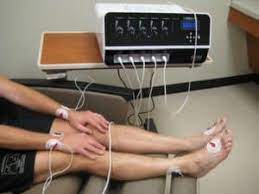 Scrambler therapy involves the use of electronic stimulation on the skin with the goal of overwhelming pain information with non-pain information.
Scrambler therapy involves the use of electronic stimulation on the skin with the goal of overwhelming pain information with non-pain information.
Electrocardiographic-like pads are placed around the area of pain.
There is not much research on the efficacy of its therapy.
There is no strong evidence that it is effective in treating neuropathic pain, although there is tentative evidence that it may be effective for chemotherapy-induced peripheral neuropathy.
There is preliminary evidence that is effective for chronic pain.
Scrambler therapy involves 16 types of waveforms.
The waveforms are combined to create a variety of sequences of electrical stimulation.
The electrical stimulation is applied to the skin via pairs of electrodes, which are applied in the painful dermatomes proximally and distally to the painful area.
The intensity of signal is increased in five to ten minute intervals until the patient feels a relief of pain or the scrambler signal intensity is at the lower threshold for causing pain.
The electrical signals in scrambler therapy are thought to stimulate C-fibers of the affected dermatomes.
C-nerve fibers then transmit the electrical signal to the brain via the spinal cord and lead to changes in pain perception in the central nervous system.
Changes in pain perception include decreased central nervous system hyper-responsiveness to the pain signal and a decrease in continuous pain signal input.
The decreased pain input is thought to be due to the pain signal travelling from the affected area to the brain being “scrambled” or diluted by many other scrambler signals also travelling to the brain from the affected area.
Scrambler therapy has been shown to decrease pro-inflammatory, pro-nociceptive peptides such as nerve growth factor, leading to analgesic effects after the treatment.
Unlike transcutaneous electrical nerve stimulation in which the analgesic benefit has only been seen during and sometimes in the immediate hours after treatment, treatment with scrambler therapy produces long lasting pain relief.
Scrambler therapy should not be used in those with implanted pacemakers, implantable defibrillators, spinal cord stimulators or peripheral nerve stimulators nor in those with uncontrolled epilepsy.
Dermatologic adverse effects at the site of electrode placement are rare: dermatitis and eccymosis.
No systemic adverse effects have not been reported.
In a meta analysis of 7 randomized controlled trials involving 287 patients with chronic pain, scrambler therapy reduced pain and analgesic use as compared to the control groups.
